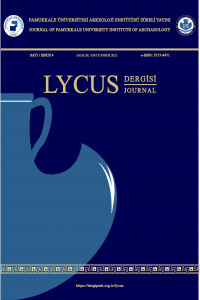Notes on Late Roman Unguentaria from Hierapolis in Phrygia (Turkey): a Contribution to the Study of the Contents
Abstract
The paper presents the results of a functional study of Late Roman unguentaria from Hierapolis of Phrygia, which includes the chemical characterisation of organic residues found in 30 stamped vessels by means of the GC-MS technique. Evidence from recent archaeological and archaeometric analyses suggests that LRUs were manufactured in western Anatolia.
The study, centred on the identification of chemical biomarkers, aims to understand the formulation of the actual contents of the unguentaria, together with the production techniques used for balms and ointments. A key substance present in the LRUs analysed is storax resin, obtained from Liquidambar orientalis, a deciduous tree endemic to south-western Turkey and the island of Rhodes. The pharmacological characteristics of storax resin – well known in antiquity for its healing properties – are also discussed.
Keywords
Hierapolis of Phrygia Late Roman Unguentaria GC-MS Styrax officinalis Liquidambar orientalis
References
- Grazia Semeraro - Full Professor of Classical Archaeology, Dept of Cultural Heritage, University of Salento, Lecce. grazia.semeraro@unisalento.it. ORCID: 0000-0002-0027-6280.
- Maria Valentina Aquilino - Ph.D. Graduate, Department of Cultural Heritage, University of Salento, Lecce. valentinaquilino@libero.it.
Notes on Late Roman Unguentaria from Hierapolis in Phrygia (Turkey): a Contribution to the Study of the Contents
Abstract
The paper presents the results of a functional study of Late Roman unguentaria from Hierapolis of Phrygia, which includes the chemical characterisation of organic residues found in 30 stamped vessels by means of the GC-MS technique. Evidence from recent archaeological and archaeometric analyses suggests that LRUs were manufactured in western Anatolia.
The study, centred on the identification of chemical biomarkers, aims to understand the formulation of the actual contents of the unguentaria, together with the production techniques used for balms and ointments. A key substance present in the LRUs analysed is storax resin, obtained from Liquidambar orientalis, a deciduous tree endemic to south-western Turkey and the island of Rhodes. The pharmacological characteristics of storax resin – well known in antiquity for its healing properties – are also discussed.
Keywords
Hierapolis of Phrygia Late Roman Unguentaria GC-MS Styrax officinalis Liquidambar orientalis
References
- Grazia Semeraro - Full Professor of Classical Archaeology, Dept of Cultural Heritage, University of Salento, Lecce. grazia.semeraro@unisalento.it. ORCID: 0000-0002-0027-6280.
- Maria Valentina Aquilino - Ph.D. Graduate, Department of Cultural Heritage, University of Salento, Lecce. valentinaquilino@libero.it.
Details
| Primary Language | English |
|---|---|
| Subjects | Archaeology |
| Journal Section | Research Articles |
| Authors | |
| Publication Date | December 31, 2021 |
| Acceptance Date | December 27, 2021 |
| Published in Issue | Year 2021 Issue: 4 |
Lycus Dergisi, Anadolu Arkeolojisi, Tarihi Coğrafyası olmak üzere Prehistorik Dönem’den başlayarak, günümüze kadar olan kültür mirası, buluntular, arkeolojik kazı ve yüzey araştırmalarının sonuçları, restorasyon, konservasyon, müzecilik, antropoloji, epigrafi, etno-arkeoloji gibi bilimsel çalışmaları kapsar. Bunların dışında ilk defa yapılan tespitler, uygulamalar ve analiz çalışmalarının yer aldığı yazıları içerir.


